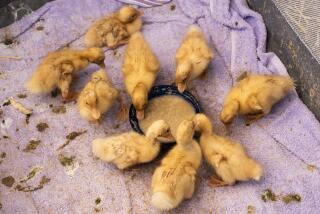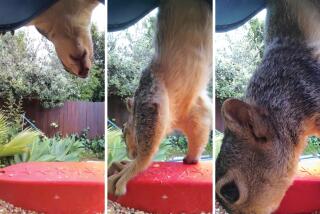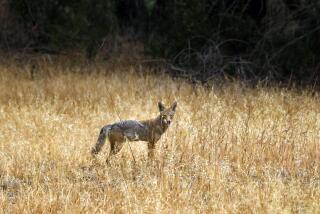Feathered Friends Have 2 True Fans
The problem, Charles Fernow says, is stray bits of fishing line. And wheeling, laughing kids who chase frightened ducks and geese across sun-drenched grass at Fountain Valley’s Mile Square Park. Not to mention the adults who toss botulism-breeding bread chunks in the pond, despite signs every few hundred feet telling them not to.
So many dangers. And only two people to cluck their tongues and do something about it.
But that’s the lonely plight of the “Bird Protectors.”
Each morning, Fernow, 67, and his friend, Eleanor Elmore, 76, arm themselves with rakes and a duct-taped video camera and make their way to this tranquil block of green in hopes of making life a little less risky for the birds that live here.
While Orange County park crews target wind-scattered food wrappers and empty cups, Fernow and Elmore focus on subtler dangers that sometimes, they feel, only they care about.
“A lot of people we talk to are enthusiastic about what we are doing, but we don’t seem to get any help,” Fernow says, adding that fishing line can ensnare unsuspecting birds. “They get that fishing line wound around their legs and it tightens and cuts off the circulation and they can lose legs.”
Saturday could be the Bird Protectors’ busiest day of the year. Hundreds of children 15 and younger are expected to join the park’s annual Youth Fishing Derby in hopes of snagging trout and catfish stocked in the pond.
Fernow sees trouble already.
“Last year, they had over 3,000 people here,” he says, trepidation creeping into his voice. “The birds were really stressed.”
The roots of the problem are anglers who cut snagged fishing line and leave it near the park’s two ponds, each a way station for two dozen varieties of migratory birds and a small permanent population of geese and ducks.
Cleaning up the fishing line is not a high priority for park crews, who are charged with maintaining the 640-acre spread. Fernow and Elmore fill the void.
“If we had more people like them, our parks would be in better shape,” said Richard Huffnagle, the park’s supervising ranger. “Through their efforts, they probably have prevented a lot of waterfowl from being hurt.”
It takes a certain perseverance to find translucent fishing line at the water’s edge. Fernow cobbled together tools for the task, cutting round-edged lawn rakes off in a straight edge and attaching them to the ends of telescoping net poles used by pool tenders.
Pushing the rakes in front of them, Fernow and Elmore wend their way around the ponds in opposite directions until they meet at the far side.
Some days they scrape up yards of fishing line. They also gather floating sticks and other debris that can snag and break anglers’ lines.
Neither of the Bird Protectors is shy about chiding people who let children chase birds (which sometimes injure themselves scampering away) or who violate the park’s feeding ban (uneaten bread breeds botulism, which has killed scores of birds).
Not everyone appreciates being told they’re breaking the law, which is why Fernow hauls around a video camera to record infractions and interactions with park-goers. “I hate to do that, but I feel like I have to,” he says.
Fernow, who retired eight years ago from Orange County Vector Control, has been fishing for line for more than four years. Elmore, a former worker in the county accounting department and a one-time long-distance truck driver, joined in about three years ago.
Their acts of compassion have turned into compulsion. They fret over a missed day. And the pair aborted a planned Montana vacation last summer because they feared the fishing line would pile up back at the park.
“I really hope we can get some help,” Fernow says. “But I feel directly responsible. Since I’m the only one that realizes this is going on here, I don’t have any choice. A lot of times I’d rather stay home.”
He began the task out of a vague mix of emotions: a Christian belief that animals were placed on Earth to be cared for by people, and consternation over seeing birds entangled--sometimes killed.
“I could see there was a lot of pain and suffering going on with the animals,” he says. “I’ve always liked animals, but I wasn’t what you’d call a bird fancier. These could be any animal. The pain and suffering got to me.”
Elmore became involved because Fernow was. The two attend a Baptist church near the park. When Fernow had heart bypass surgery, Elmore volunteered to drive him around until he was back to normal. One of the places he needed ferrying to was the park.
“I went around helping him and got involved,” says Elmore, who developed an affinity for animals growing up on an Illinois farm.
Fernow is divorced, Elmore widowed. But they talk like a long-married couple, finishing each other’s sentences and using shorthand to refer to shared events. Sometimes, though, communication breaks down.
A few weeks earlier, they found a mixed-breed duck with a broken foot. They named it Cinnamon and took it to the Wetlands and Wildlife Care Center in Huntington Beach.
Fernow can’t quite come up with the name for the type of mixed-breed duck they found. “Eleanor, what do they call that mix?”
“It’s a duck.”
“No, what do they call it?”
A pause.
“Cinnamon?”
“No, the name they use .... “
A longer pause.
“Peking?”



